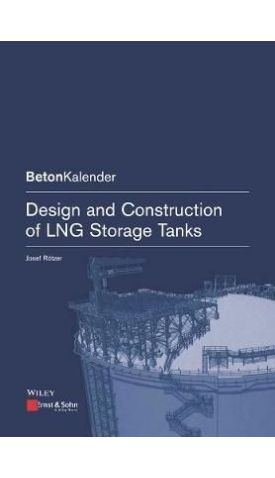אנו משתמשים ב-Cookies כדי לשפר את החוויה שלך. כדי לקיים ההנחיה החדשה של e-Privacy, עלינו לבקש את הסכמתך להגדיר את ה-Cookies. קבלת מידע נוסף.
331.00 ₪
Design and Construction of LNG Storage Tanks
331.00 ₪
ISBN13
9783433032770
יצא לאור ב
Berlin
מהדורה
Volume 1
זמן אספקה
21 ימי עסקים
עמודים
136
פורמט
Paperback / softback
תאריך יציאה לאור
4 בספט׳ 2019
מחליף את פריט
9783433029602
שם סדרה
Beton-Kalender Series
Worldwide, the use of natural gas as a primary energy source will remain vital for decades to come. This applies to industrialized, emerging countries and developing countries. Owing to the low level of impurities, natural gas is considered to be a climate-friendly fossil fuel because of the low CO2 emissions, but is at the same time an affordable source of energy.
In order to enable transport over long distances and oceans (and hence create an economic and political alternative to pipelines) , the gas is liquefied, which is accompanied by a considerable reduction in volume, and then transported by ship. Thus, at international ports, many LNG tanks are required for temporary storage and further use. The trend towards smaller liquefaction and regasification plants with associated storage tanks for marine fuel applications has attracted new players in this market who often do not yet have the necessary experience and technical expertise. It is not sufficient to refer to all existing technical standards when defining consistent state-of-the-art specifications and requirements.
The switch to European standardisation has made it necessary to revise and adapt existing national codes to match European standards. Technical committees at national and international level have begun their work of updating and completing the EN 14620 series.
In the USA, too, the corresponding regulations are also being updated. The revision of American Concrete Institute standard ACI 376 Requirements for Design and Construction of Concrete Structures for the Containment of Refrigerated Liquefied Gases, first published in 2011, will be completed in the spring of 2019, and the final version, published in autumn 2019.
This book provides an overview of the state of the art in the design and construction of liquefied natural gas (LNG) tanks. Since the topic is very extensive and complex, an introduction to all aspects is provided, e.g. requirements and design for operating conditions, thermal design, hydrostatic and pneumatic tests, soil surveys and permissible settlement, modelling of and calculations for the concrete structure, and the actions due to fire, explosion and impact. Dynamic analysis and the theory of sloshing liquid are also presented.
| מהדורה | Volume 1 |
|---|---|
| עמודים | 136 |
| מחליף את פריט | 9783433029602 |
| פורמט | Paperback / softback |
| ISBN10 | 3433032777 |
| יצא לאור ב | Berlin |
| תאריך יציאה לאור | 4 בספט׳ 2019 |
| תוכן עניינים | 1 Introduction 2 History of natural gas liquefaction 2.1 Industrialization process and energy demand 2.2 Beginnings of gas liquefaction 2.3 The first steps to ship transport 2.4 Algeria becomes first exporter 2.5 Further development with peak-shaving systems 2.6 The first German LNG tank in Stuttgart 2.7 Wilhelmshaven - the attempt of a German import terminal 2.8 The liquefaction of gas in Australia 2.9 Emission Control in the EU 3 regulations and areas of application 3.1 History of the regulations 3.2 EEMUA No. 147 and BS 7777 3.3 EN 1473 Liquefied natural gas plants 3.4 EN 14620 Design and construction of LNG tanks 3.5 API 620 The US regulation for steel tanks 3.6 API 625 Coupling of concrete and steel 3.7 ACI 376 The US regulation for concrete tanks 4 Definition of different tank types 4.1 Definition and development of tank types 4.2 Single containment tank system 4.3 Double containment tank system 4.4 Full containment tank system 4.5 Membrane tank system 5 Requirements and design 5.1 Requirements of the operating status 5.2 Thermal design 5.3 Liquid and gas pressure test 5.4 Soil investigation, soil parameters and permitted settlements 5.5 Susceptibility to soil liquefaction 6 Calculation 6.1 Requirements for the calculation of the concrete structure 6.2 Requirements for the modeling of the concrete structure 6.3 Framework models for discontinuity areas 6.4 Liquid Spill 6.5 Fire load cases 6.6 Explosion and Impact 7 Dynamic calculation 7.1 Theory of the sloshing liquid 7.2 Calculation method according to Housner 7.3 Calculation method according to Veletsos 7.4 Regulations in EN 1998-4, Annex A 7.5 Earthquake design of LNG tanks 8 Execution and erection 8.1 Construction conditions and construction 8.2 Wall formwork 8.3 Reinforcement 8.4 Pretension 8.5 Equipment (inclinometer, heating) 8.6 Concrete joints 8.7 After-treatment of concrete surfaces References |
| זמן אספקה | 21 ימי עסקים |



Login and Registration Form